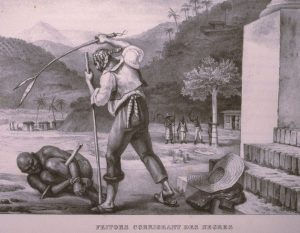Destiny Nevarez
Eng 302
Professor Kappes
March 18, 2018
Transatlantic Slave Trade
The Transatlantic Slave Trade is when millions of African Americans were taken away or tricked out of their homes under false pretenses to be sold as slaves. The conditions they were required to live as they were transported overseas were horrid. African Americans were chained and offered minimal food. Whites gave them just enough food to keep them alive. African Americans were forced to entertain whites aboard the ship and if they refused were beat or thrown overboard. As upsetting as their living situations as slaves were, many African Americans made the best of their lives doing what was necessary to have honor, survive up to beating and killing their own people. Oroonoko by Aphra Behn and the illustration “Whipping a Slave” by Jean Baptiste Debret both tell stories of the horrifying lives and punishments African Americans had to endure during slavery.
Oroonoko is about a prince who lived a lavish life until he fell into a forbidden love that resulted in him becoming a slave. Oroonoko whose name was now Caesar encouraged other slaves to revolt and be by his side that it would be more honorable to fight and die than to die a slave. He said “They suffered not like men who find a glory and fortitude in oppression but like dogs that fawned the whip and bell and fawned the more they were beaten”. (P.61) Once this was said the revolt occurred but it all backfired once they were caught and they chose to abandon him. Caesar was then chained to a stake and beaten naked in such a cold-blooded inhumane way. He was beaten to the point where the whips were breaking his skin causing him to bleed. “To complete his rage, he saw every one of those slaves, who, but a few days before, adored him as something more than mortal, now had a whip to give him some slashes”. (P.67) He was beaten by his own people because they feared what could be done to them and their families. Caesar was put to be an example of what can happen to slaves who disobey their masters.
“Whipping a Slave” is by Jean Baptiste Debret in Brazil in between 1816-1831. The first thing you notice are the two men in the front of the photo. The white male is in the middle of beating an African American. The African American male is tied up. He was a stick under his knees to restrain him from moving with his hands tied over and holding his knees together. There are 4 people in the back 3 African Americans and what seems to be a white female. One of the men in the background is tied to a tree while the other male has his hand up with a switch ready to beat him. There seems to be a woman next to him with a switch in her hand also.
The first similarity between Oroonoko and “Whipping a slave” is how they were both restrained from their hands tied to wood. Slaves were treated worse than animals because not even animals get restrained from their hands to keep from moving. This shows that their masters wanted the slaves to feel helpless with no fighting chance. Oroonoko gives a reader the chance to imagine how slaves had to beat each other while “Whipping a slave” gives a visual and shows how slaves had to be beaten by other slaves. Their masters not only did this for enjoyment but to show who was in control while slaves not only did it because they were forced but to make their master feel honored and pleased in hopes none of this would happen to them. They both show the punishments slaves had to endure physically from being beaten to beaten mentally by having no choice but to beat their own people.
“Whipping a slave” and Oroonoko show the horrible things African Americans had to go through during the Atlantic slave trade. They not only went through hard times but had to commit things they may not have been proud of too survive on their own people.

Work Sited
- Behn, Aphra, Todd, Janet. Penguin Books, 2003.
- Whipping a Slave, Brazil, 1816-1831
Jean Baptiste Debret, Voyage Pittoresque et Historique au Bresil (Paris,1834-39), vol. 2, plate 25, p. 83. (Copy in the John Carter Brown Library at Brown University)
http://www.slaveryimages.org/images/collection/large/NW0207.JPG

